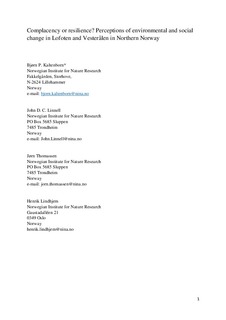Complacency or resilience? Perceptions of environmental and social change in Lofoten and Vesterålen in northern Norway
Journal article, Peer reviewed

Åpne
Permanent lenke
http://hdl.handle.net/11250/2443156Utgivelsesdato
2017Metadata
Vis full innførselSamlinger
- Publikasjoner fra CRIStin - NINA [2364]
- Scientific publications [1392]
Sammendrag
Arctic and northern coastal regions are among the least developed in the world in terms of density of settlements, population and resource exploitation. It is often assumed that these regions will be frontiers of future change, conflict and opportunity due to climate change, new transportation routes, geopolitical tensions and increasing demands for their natural resources. But to what degree do global discourses about future challenges in northern coastal areas align with the perceptions and concerns of people living there? Identifying the mainstream public concepts of change can be essential for developing effective and legitimate policies for coastal regions. We surveyed a representative sample of residents in the Lofoten e Vesterålen archipelago in Northern Norway to identify their perceptions of the main conflict issues and drivers of change facing their region. Petroleum exploration, infrastructure development, the fishing industry, and uncertainty about future municipal governance and public services emerged as the key conflict themes. Perceptions of drivers group in positive forces; developments and improvements in transportation, the fishing industry, tourism, new marine industries and cultural heritage protection, as well as negative factors; climate change, aging and declining rural populations, degrading of the cultural landscape due to reduced grazing, and bureaucratic obstacles in the fishing industry. The main attention is on social and economic drivers of change, as well as “doorstep” concerns rather than global discourses. National or global environmental and geopolitical issues are largely absent in the responses.